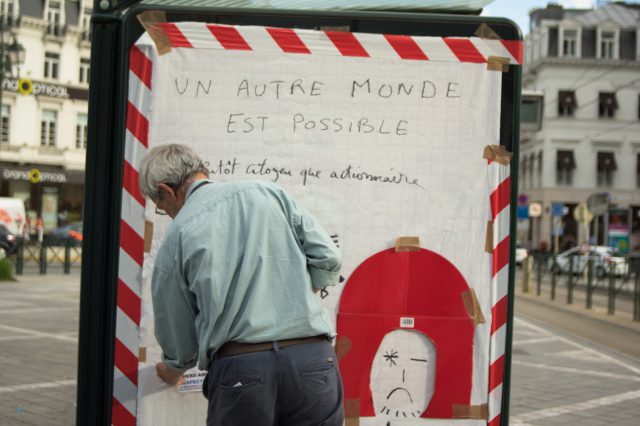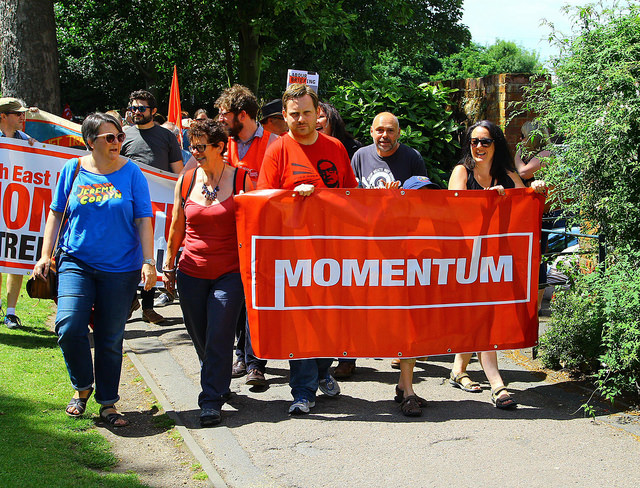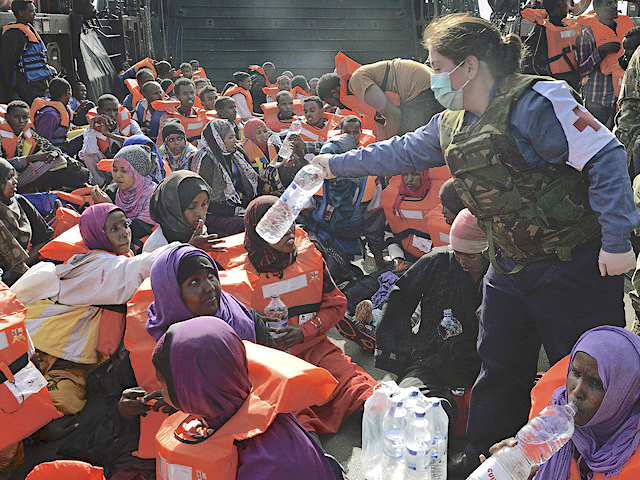In Wag the Dog, Dustin Hoffman plays a Hollywood producer recruited to stage a war so as to save the president from a sex scandal. At one point he complains to the president’s aide (Robert De Niro): It’s not fair! Nobody knows the producer! Everyone knows the director and the actors, but not the producer. But I hire the director. I hire the actors. I find the script, I fund the film, I do the distribution. But who knows the producer? It’s not fair!
The left can hardly be accused of hogging the limelight. Our productions are pretty slim and nobody knows any of us – except each other. But here is the point. We don’t have celebrities because we try to foreground the issue and background the personalities – or, in our productions, shift the spotlight to a victim who, by being highlighted, carries our message better than an analysis would. Yet here is also our limitation: our productions – demonstrations, protests and the like – tend to be so ephemeral as to have no impact or, like the Occupy movement, temporary blips on the political landscape.
That isn’t always true, of course. Certain historical moments disgorge movements, leaders and events actually change things. October 1917, was one such historical moment. Leon Trotsky comments in his autobiography that had he been born a few years earlier or later, he would have been a math teacher. The Sixties were another. We’ve been in a trough ever since. Not that seminal events and developments have not taken place over the past half-century, but that, having done so “in between” historical moments, they were either inadequately perceived at the time (the rise of neoliberal economics, for example, in the BRICS countries as well as the West, or the ongoing saga of climate change) or did not have the political actors capable of harnessing them (Bush or Clinton in the wake of 1989, Obama regarding a whole slew of key issues he understood but failed to address). Certainly, Nelson Mandela, the ANC and the fall of apartheid represented a major political event, yet, again, it proved localized and, looking at the present state of South Africa and its government, also politically ephemeral, non-replicable.
Historical moments seem to fall into two categories. Most dramatic and visible are those moments when history turns, when events and processes break the continuity of the present and a new – or at least fundamentally revised and restructured – future might be constructed. These are times of revolution, political, economic, technological and social upheaval, times of what Charles Tilly calls “contentious politics” expressed through social discontent, unstable politics, wars, religious, ethnic, national and class conflicts. In these moments leaders and intellectuals, political parties, social movements, religious crusades and other ideological actors succeed in shattering the prevailing order, seldom, it must be admitted, in progressive ways).
More common and long-lasting, however, are those long interstices between revolutions, themselves “moments,” stagnant and un-felt as opportunities for change by most people. These are times, as we are living in at this historical moment, that cannot produce breakthrough events. Despite the crying need evident to all, the dead weight of comfort for populations that possess the power to change, combined with the suffocating pervasiveness of the hegemonic powers and their messages – the “system” – effectively conceal sources of injustice and stifle resistance.
The latter seems to describe our moment – or, as William Robinson characterizes it, the present “interregnum.” In Left-Wing Melancholia, Enzo Traverso explains why. The past two centuries, he notes, opened with hope, revolution, new possibilities: the 19th Century with the Enlightenment and the American and French Revolutions; the 20th with the Russian Revolution that carried us into the often (if only apparent) revolutionary process of decolonization, the formulation of human rights conventions, the Sixties other (mainly conceptual) advances in global human liberation, including gender-based categories and hierarchies. These were centuries when the future had to be invented; the “generation gap” meant that the previous generation could no longer show the way.
By contrast, Traverso observes, the 21st Century opened to dystopia. Three “turns” elevated transnational capitalism to unchallenged hegemony: the rise of neoliberalism in the 1970s, the decisive fall of Communism (and socialism) in 1989; and 9/11 when all resistance to the neoliberal world order was repressed as a form of “terrorism.” Although these were generally seen at the time as positive events that actually confirmed the strength and rightness of the prevailing capitalist system (the “end of history,” the Global War on Terrorism), from the perspective of decades they seem to have eliminated any possibility of replacing a repressive, violent, unequal and unsustainable world system with something better. Through varied forms, writes Traverso,
from science fiction to ecology studies, the dystopias of a future nightmare made of environmental catastrophes replaced the dream of a liberated humanity,… the concrete utopias of collective emancipation turned into individualized drives for the inexhaustible consumption of commodities….. The utopias of the past century have disappeared, leaving the present charged with memory but unable to project itself into the future. There is no visible “horizon of expectation.”
Neoliberalism has abolished the future; we live in an eternal present. Enzo Traverso references Frederic Jameson’s observation that the end of the world is easier to imagine than the end of capitalism.
It would seem that neoliberal transnational capitalism has won. (Indeed, we often played into its hands. Remember the bumper sticker on every liberal’s car in the 1990s: Think Globally, Act Locally? As we channelled ourselves to local activities, who do you think was filling the vacuum and acting globally?) Sure, there are still localized contests between various strains of social democracy, unfettered neoliberalism and state-capitalist systems. But most of us live in what Patricia McManus in a recent article in New Left Review calls “happy dystopia.”
Overcoming Our (Un)Historical Moment: The Tasks At Hand
Yet the three “turns” do, in fact, represent major breaks in the ongoing historical moment. We live within a great contradiction. Global capitalism has won a pyrrhic victory, emerging hegemonic but spent, while we have thus far proven unable to articulate a systemic alternative, let alone inspire the masses or mount effective resistance.
Can we envision a global turn equivalent to those of the 19th and 20th Centuries, and generate the enthusiasm needed to sustain our own global revolution? Are we able to overcome the “melancholy” and malaise that has so undermined the left’s ability to mount a genuine challenge to capitalist hegemony by forging a global agenda, a program that incorporates all our issues while offering nothing less than an alternative world system? Can we overcome the siloing, the focus mainly on the local, the NGOization of the grassroots, the identity politics and the obsessive individualism instilled in us by a manipulative neoliberalism in order to mount a truly global and genuinely effective world movement? Are we capable of becoming as globalized as the capitalists, their political and regulatory agents, and those that secure their domination, and are we able to articulate a just alternative to the current world system?
With little political wind at our back, in a time of stagnation (despite the protests), we must become our own producers. Just as the president’s aides in Wag the Dog had to produce a war out of nothing, so, too, do we need to produce a revolution in a decidedly unrevolutionary time.
When one surveys the literature of the left, all the elements needed to enact systemic change at a time when capitalism is widely seen as failing seem to be present. Certainly searching critiques of capitalism are readily available. Among the many hundreds of books, articles reports and analyses, we might mention the more academic work of Immanuel Wallerstein, David Harvey, Carolyn Nordstrom, Joseph Stiglitz, Barbara Ehrenreich, William Robinson and Robert Heilbroner (among many others more specialized); analysis more known to activist circles (Howard Zinn, Frantz Fanon, Eric Hobsbawm, Tariq Ali, Mike Davis, Samir Amin and analyses circulated through such activist NGOs as War on Want and the Transnational Institute); and on to anti-capitalist authors who have broken through to the wider public (Naomi Klein, Thomas Piketty, Arundhati Roy, Slavoj Žižek, Noam Chomsky, Susan George and George Monbiot, again, among many others).
One may also point to a plethora of activist groups, both grassroots and international. The World Social Forum and occasional Regional Social Forums immediately come to mind, of course, as does the Left Forum in different variations in many countries and universities. Attac is a large anti-capitalist activist network operating in some 35 countries, while other networks – anti-globalization, environmental, LGBTQ, anti-war and others – can be mobilized in response to urgent calls. And then there are the thousands of local organizations, NGOs, activist groups, neighborhood associations and political circles in every country who contribute to the struggle in many ways, both practical and programmatic.
Our issues, even local ones, are ultimately transnational, as is the capitalist world system we must work to replace. Radical and progressive organizations also exist transnationally, and many participate in transnational networks of like-minded groups. But we have as yet to take the conceptual and organization steps that will truly globalize our efforts.
The Need for Infrastructure
What seems to be lacking is an infrastructure that connects theory and analysis with activism. In our struggle to globalize, to achieve a level of global organization, un-siloed dialogue, critical systemic analysis and a collective agenda at the level of corporate globalization, we appear to need less networking and more of an organizational base capable of translating our collective, if siloed, analyses and single-issue or localized actions into a coherent movement. That process, which might have happened on its own in a historical moment that generated the needed commitment, leadership, structures and impelling ideology, must today be artificially created.
Why infrastructure? A few reasons. First, networking is not enough – or rather needs an integrated circuit in which to work effectively. For that reason, the vast amount of critical information at our disposal get blocked and siloed. We lack vehicles for communicating across siloes, including languages and regions, most of the Global South extremely distant from the activities of North organizations and groups. As a result, struggles that should be integrated and globalized remain localized and siloed. Just as important, activists lose the big picture. The extreme atomizing of society instilled by neoliberalism and its success in channelling our energies into local issues and initiatives have had their cumulative effect: young people (and if you think about it, anyone under the age of 50, even 60, has grown up under a neoliberal regime) have lost the Big Picture.
Of all the authors mentioned above, only a few, led by Naomi Klein, have brought the very term “capitalism” itself into popular usage. In the meantime, groups focused on what would seem to be inherently global issues such as climate change or world poverty work mainly with select siloed groups on localized “projects” – a consequence of the NGOization process. Other less organized groups and gatherings – anti-globalization protests, World Social Forums, actions of European indignados – tend to act either in reaction to events (such as G-20 meetings) or in passing assemblies, with only ephemeral results. This is not to take away from the significance of such political displays; we must, of course, develop specialization and the ability to act locally if we are to tackle in a meaningful way the myriad manifestations of global ills. It is only to argue that such manifestations need to be linked in a wider systemic-wide and synergetic relationship as well.
Second, critical organizations, those of the grassroots above all, are notoriously under-resourced and unable to mount sustainable and effective campaigns. Infrastructure provides the venue, the structures and the collective resources upon which our ability to network, organize, share analyses and materials, strategize, plan campaigns, train activists, reach out to the public, evaluate and follow-up, and, not least, financially sustain our collective efforts, all depend – particularly if we aspire to link our individualized campaigns into effective campaigning for progressive systemic change on a global scale.
Third, the young generation of left/progressive activists tends to eschew organizations for looser forms of political action: spontaneous and reactive, if networked, protests, popular struggles and social movements; the more established of them might work from within NGOs. Few find political parties their vehicles of choice, although occasionally a political figure arouses them. This is not the place to evaluate their effectiveness – this is yet another issue that deserves a fuller airing. But whatever the case, infrastructure provides a place where those who think that sustained, effective and focused political activity, especially on a global level, requires organization and resources, can interact with activists of all types, places and issues.
Infrastructure is a resource available to everyone, and everyone in any kind of political form can access it, utilize it, without joining anything or sacrificing operational freedom. It is to be hoped that activists would understand the importance of focusing and multiplying the effects of their actions. Infrastructure can be utilized to initiate campaigns and actions, or merely coordinate and highlight ongoing activities, or serve as merely a resource for finding and accessing other like-minded organizations or sources of critical information. As such it can “go with the flow” in terms of the changing and varying forms grassroots political action takes.
Infrastructure functions as a floor, a structure to which groups and organizations can plug into, and not as a roof organization. In the world of the left where our disparate organizations jealously guard their ideological “turf” and their spheres of action, this is a decided advantage. Infrastructure has neither hierarchy nor ownership. True, what I am envisioning here is an infrastructure composed of organizations, groups and activists with a clear left perspective extending into the progressive community. And, true, I would argue that replacing transnational capitalism provides both a coherent systemic framework within which to situate ourselves as well as a shared focus.
But by infrastructure I am speaking of a structure that would allow and facilitate the strategic interpenetration of issues, not amalgamating them into some all-encompassing meta-solution or roof organization. Let a thousand flowers bloom, but provide the fertile soil.
Connecting the Dots, Deepening the Analysis
Infrastructure also connects issues, and can help bridge the distance between localized agendas and global ones. Few radical environmentalists talk about the impact of the military on climate change, although it is the world’s largest polluter. How could we better connect anti-global protests to the effects of WTO policies on women in the Global South? How can we make such fundamental issues as global peasant struggles or the corporate stripping of the Congo’s resources at the cost of millions of lives more visible? What, in fact, are our alternatives after capitalism, and how we ensure the democratic, inclusive and sustainable ones over the controlling and dystopic? The point is not to make us all experts on everything. That is wasteful and counterproductive. It is, rather, that we find ways to link our issues, to give priority and visibility to key issues that have been crowded out by others and, not least, to identify key elements to target in a coherent global strategy of “creative destruction.”
Harvey suggests focusing on seventeen key contradictions of capitalism, the world system’s Achilles’ Heel. Bertell Ollman points to market mystification as a key target. Eric Olin Wright emphasizes our coming up with a workable alternative (“demanding an economic system that both meets people’s basic needs to live a flourishing life and allocates rewards above this level of on the basis of the burden people take on in their work”). Antonio Gramsci helped us understand how to build broad-based consensus. I’ve suggested that we focus on how the capitalist powers-that-be enforce their hegemony. And there are many other analyses and programs. But how can these potent proposals lead to a genuinely effective global strategy and courses of action without an infrastructure? And yet, nothing approaching that exists today.
Bridging the Disconnect Between Engaged Intellectuals/Academics and Activists
A crucial role that infrastructure can play is to bridge the debilitating disconnect between activists on the ground and university- or think tank-based academics, researchers, analysts and, not least, engaged intellectuals like Chomsky, Klein, Davis and others. Grassroots activists tend to lack access to privileged forums of intellectual discussion, certainly to articles embargoed for a high fee by privatize companies, to books that are laden with jargon, time-consuming, often available only in foreign languages and expensive, and thus to academic concepts and analyses that could measurably improve their ability to understand, strategize and develop effective campaigns. For their part, activists engaged in struggles in “the real world” could raise questions and provide data that, if addressed by analysts, would ground their own intellectual inquiry, thus lending it greater focus and usefulness.
Articulating an Alternative World System
Once we have the means to pool our views and priorities, a primary task is to articulate the alternative world system we envision, and how it would impact our diverse issues and constituencies. While a few people have taken a stab at this, we are far from having formulated a vision or, better, plan of where we are going as a global movement. The Occupy movement well demonstrated that it is one thing (and fairly easy) to mobilize people on the basis of their shared grievances, but it is quite another to keep them mobilized, directed and effective without an end-game or even a gamebook. What, precisely, are we advocating for beyond certain reforms?
Few have thought this out more than Wright, who puts forth three foundational elements that must be part of any emancipatory world system: social power over economic power and the state (transforming the power relations of economic activity, though not eliminating the market); democracy (“people should be able to participate in decisions to the extent that they are affected by those decisions”); and equality, well-being, inclusiveness and cultural pluralism, social justice, environmental sustainability. He then suggests a number of ways by which the private enterprise market system could be transformed into a democratic and egalitarian alternative: social capitalism in which such popular agencies like Community Development Corporations and unions are strengthened, but capitalists still run things); a cooperative market economy linking the social power of workers with economic power of owners; a solidarity economy or participatory economics in which collective, people-based social power directly organizes economic activity for the benefit of fundamental human needs and is not subject to profit-maximization or state regulatory power (though state may fund, regulate or tax these enterprises; or participatory socialism in which the state and civil society jointly control production (a combination of state socialism and solidarity economy).
Immanuel Wallerstein presents a less detailed program, but one which envisions a world system that is humane, inclusive, just, counter-hegemonic and counter-capitalist. It must embody the antithesis of relentless economic growth and the exploitation of people and the environment. It must be non-hierarchical, at least in terms of flattening the huge disparities that exist between the classes worldwide, and must be able to address polarization and alienation – of people from people, from the natural world and the environment, from their own lands and from their own identities. Harvey speaks of ‘Revolutionary Humanism‘, Robinson of a Global Democratic Socialist Project that, like Wright’s, replaces the dominant logic of the market with a social logic.
However we conceive of the next world system, there are issues few of us on the left are familiar with that we must somehow plug into our discussions, notably issues revolving around technology, not our forte. A 21st Century socialism (using the term in the broadest sense) must take into account the end of labor as we know it – with the exception, perhaps, of casual labor – as automation takes over the workplace.
As transnational capital thoroughly privatizes, commodifies and monetizes all aspects of nature and humanity, Harvey tells us in Seventeen Contradictions and the End of Capitalism, “It is not entirely beyond the realms of possibility that capital could survive…by a capitalist oligarchic elite supervising the mass genocidal elimination of much of the world’s surplus and disposable population while enslaving the rest and building vast artificial gated environments to protect against the ravages of an external nature run toxic, barren and ruinously wild…. It would be wrong to rule [such dystopian scenarios] out as impossible blueprints for the future of a less-than-human humanity….”
Class structures going back to Marx’s analysis will be utterly transformed, making it necessary to fundamentally reinvent a just, humane and sustainable alternative. Indeed, as technology fundamentally alters humans themselves – the younger readers reading this piece may well live 400-500 years – so, too, is human life being reinvented. Few discussions of the implications of all of this seem to cross the division between C.P. Snow’s “two cultures,” another critical expression of siloing.
Strategizing
The project of constructing an alternative world system involves not only formulating or promoting abstract models, of course. Robinson identifies reminds us that “World revolutions involve constellations of local, regional, national and transnational rebellions and revolutions that have long-term consequences for changing world orders.” He thus stresses the importance of theorizing the emancipatory potentials of such crises as the 2008 financial collapse, austerity measures imposed by the IMF and EU, the Arab Spring and the Occupy movement, as well as the rise of the global justice and anti-globalization movements (asking, on the way, if present-day movements possess genuinely revolutionary potential or serve merely as reformist mechanisms), worldwide peasant and workers’ organizations, and the organizing potential of gatherings such as the World Social Forum.
This must involve a multilateral dialogue among actors, analysts, the people and even policy-makers on both practical and theoretical levels, a complex task requiring infrastructural support. While resistance itself is often fragmented, spontaneous, lacking in structure, strategies and programs, Robinson also points to the need for “sturdy organizations” that can give substance and continuity to popular upheavals – whether organizations per se or those connected by an infrastructure.
All this, in turn, could lead to the formulation of a global agenda and the mobilizing of our forces around it. Informing that agenda, which we must fight out in the broad political arena, are meta-strategies that help us focus our attacks as well as our alternatives on the weakest points of the capitalist system. Harvey lists seventeen such points, while Robinson argues in particular for mobilized global labor action at the points of production and mobilizing communities at the point of reproduction.
Then there is the question, what are the most effective transformative strategies? Wright asks two fundamental questions: Under what conditions would it be possible to genuinely abolish the complex and far-reaching “economic ecosystem” of capitalism, its institutional basis, the private enterprise market system? And what would need to be done to transform that abolition into a truly democratic egalitarian alternative? Although many of us speak in terms of world revolution, Wright argues that the ruptures created in the system are only useful when new participatory norms and institutions have already replaced the old forms as the core of the global economy.
Until that moment, William Robinson proposes “real utopian transformation” comprised of interstitial processes (constructing alternatives on the ground and expanding them, like the cooperative movement or the movement for social solidarity economies) supplemented by symbiotic processes (utilizing states to extend progressive programs). What differentiates his “non-reformist reforms” from reformism is that they are geared towards advancing a broader, clearly articulated post-capitalist agenda.
Another tack, symbiotic to be sure, emphasizes global government, or at least more integrated but democratic world system that promotes global justice, security, sustainability and accountability. Proponents of this strategy see the system of “separate but equal” (in principle) states as a primary roadblock to any progressive change, since states, by their nature, act in the interests of their own peoples – or of their own elites – rather than towards a common good.
Towards a Globalized Infrastructure: The People Yes! Network
What I’m arguing is that critique, protest and resistance cannot stand on their own; they need a mechanism by which grievances and utopian visions can be translated into effective political programs both local and global, and then pursued via effective strategies. This has always been true, but while some historical moments engendered popular movements for revolutionary or progressive change that spawned mechanisms for achieving them as well, the current historical moment is fragmented. As is characteristic of neoliberalism, critical analysis, resistance, organization, protest, strategizing, leadership, the prioritizing and linking of issues, networking and all the other elements of radical social change are scattered and siloed. Infrastructure may not be inspiring, but it addresses the stagnation and fragmentation of our crucial historical moment.
What would such an infrastructure look like? I have scoured the web, World Social Forums and activist/NGO networks in search of a model, whether successful or not. To no avail – though it’s a big world and I could very well have missed something. So, together with a number of activists from different parts of the world, I’ve become engaged in an attempt to conceptualize such an infrastructure and start to actually create it. We call it The People Yes! Network (TPYN), after an epic 1936 poem by the American folk poet Carl Sandburg:
The people yes
The people will live on.
The learning and blundering people will live on.
They will be tricked and sold and again sold
And go back to the nourishing earth for rootholds,
The people so particular in renewal and comeback.
You can’t laugh off their capacity to take it.
The people is Everyman, everybody.
Everybody is you and all others….
Without going into great detail here, the TPYN infrastructure is comprised of several elements as depicted here:
The TPYN office, located initially in Brussels where The People Yes! Network is registered as an international NGO, will take the initiative in identifying and recruiting to the TPYN project radical, left and progressive grassroots organizations from every part of the world, as well as activists, academics and other resource people. TPYN staff – an unpaid group of core activists at this stage – will partner with activists and critical analysts the world over to create a global “infrastructure” and begin to define collective agendas and projects.
As we’ve discussed, the concept of “infrastructure” as TPYN’s organizing principle is strategic. Rather than trying to impose a structure or agenda on the thousands of disparate groups the world over, an infrastructural approach is based on the idea of voluntary association in a network that is participatory, non-hierarchical and transparent, yet structured. Organizations will join if they feel that by doing so they will be furthering their own struggles, and they can decide their level of engagement. Although the global, cross-issue, anti-capitalist TPYN network can be used merely as a source of identifying and linking with like-minded organizations, sharing analyses and materials and launching joint campaigns, it will ideally spawn global initiatives that TPYN will help formulate and coordinate.
In order to begin developing a genuinely global core of organizations, we are planning a founding conference. The idea is to invite at least one organization from 18 major regions of the world (see map), plus another 5-6 representatives of non-geographically defined issue areas such as indigenous rights, anti-globalization, climate change, health, housing, militarism, trans-geographical workers’ and peasant movements, human rights, gender rights and others, for four or five days of getting acquainted personally and politically and then brainstorming. While social media are useful tools, nothing can replace extended face-to-face encounters. Such an initial gathering of grassroots organizations represents a concrete step in “globalizing the left.”
Among the key issues the conference would focus on are:
(1) Identifying those common issues that link our many struggles. The voice of the Global South (including the South present within the Global North) has not been amplified in the setting of a globalized agenda. We need to hear their analysis and priorities in order to distil a set of meta-issues (the predations of capitalism, climate change, the arms trade and wars, corruption, gender issues, etc.) that truly define a common global program to accompany and empower our issue- and place-specific ones;
(2) Building an infrastructure. Can we come together to construct an organizational platform that will facilitate more effective coordinating, strategizing, planning, follow-up and training among a wide range of grassroots groups throughout the world, with an emphasis on defining and pursuing a common global agenda through joint campaigns?
(3) Articulating alternatives to global capitalism. Besides our immediate critiques and acts of resistance, what are we proposing as an alternative to the private enterprise market system? And how do we plan on getting there? Here is where grassroots, regional and global activists must come together with academic analysts if a coherent global agenda is to be formulated.
(4) Developing strategies for reaching people outside our circles.
A key outcome of this conference would be the establishment of regional “anchors” in each geographical region or issue-based community, which could coalesce into that global civil society network that is lacking today. Constructing a supporting infrastructure might be another major outcome.
The collaborative infrastructure itself is where both the governance of the global TPYN community takes place and where member organizations come together to set priorities and develop joint projects, all while keeping the focus on building towards an effective movement of counter-hegemony. Every two years representatives of TPYN member organizations will meet in a General Assembly hosted by one of the regions, a gathering involving both a physical gathering and on-line participation. There a Board will be elected representing the different regions and issues, which will provide oversight to the work of TPYN. Here, indeed, is where the membership meets the TPYN staff to plan collective strategies and initiatives.
Finally, as part of its responsibility in creating an effective infrastructure, TPYN will establish a resource center in order to provide the critical analysis, information, news and support for collective strategizing and effective action that any movement requires. One priority of the Resource Center will be addressing the disconnect between grassroots activists and academic analysts, for which an ‘Institute for Strategic Activism’ (its working name) is being conceived. On one level, the institute would operate as a kind of popular think tank. But the Institute would also strive to advance TPYN’s global agenda: soliciting from as wide a range of activists, analysts, political figures and others nothing less than the outlines of an alternative world order, and the forging of an effective movement to achieve it.
Harvey’s Call
The idea of constructing a global-oriented infrastructure of left and progressive forces arises out of the spirit and substance of David Harvey’s clarion call for mobilization in favor of a sustainable, human-centric world order. Capitalism, he tells us in The Enigma of Capital, “will never fall on its own. It will have to be pushed. The accumulation of capital will never cease. It will have to be stopped. The capitalist class will never willingly surrender its power. It will have to be dispossessed.”
“The seeds are sown,” then,
for a humanist revolt against the inhumanity presupposed in the reduction of nature and human nature to the pure commodity form…. But how this should be done is by no means clear and what kind of economic engine can replace that of capital is an even murkier proposition given the current state of thought and the lamentable paucity of imaginative public debate devoted to the question.
Whether it is TPYN or other organizations – and certainly there must be more than one infrastructural framework – the project of building an infrastructure necessary for having that discussion and mounting an effective struggle to follow it seems both clear and urgent.
Photograph courtesy of Joel Schalit.







